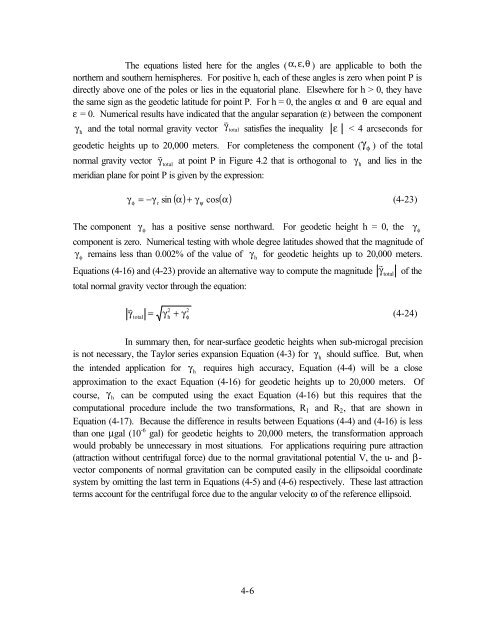WGS84RPT.tif:Corel PHOTO-PAINT - Henry A. Rowland Department ...
WGS84RPT.tif:Corel PHOTO-PAINT - Henry A. Rowland Department ...
WGS84RPT.tif:Corel PHOTO-PAINT - Henry A. Rowland Department ...
Create successful ePaper yourself
Turn your PDF publications into a flip-book with our unique Google optimized e-Paper software.
The equations listed here for the angles ( α , ε,<br />
θ ) are applicable to both the<br />
northern and southern hemispheres. For positive h, each of these angles is zero when point P is<br />
directly above one of the poles or lies in the equatorial plane. Elsewhere for h > 0, they have<br />
the same sign as the geodetic latitude for point P. For h = 0, the angles α and θ are equal and<br />
ε = 0. Numerical results have indicated that the angular separation (ε) between the component<br />
r<br />
γ<br />
h<br />
and the total normal gravity vector γtotal<br />
satisfies the inequality ε < 4 arcseconds for<br />
geodetic heights up to 20,000 meters. For completeness the component ( γ φ ) of the total<br />
r<br />
normal gravity vector γtotal<br />
at point P in Figure 4.2 that is orthogonal to γ<br />
h<br />
and lies in the<br />
meridian plane for point P is given by the expression:<br />
γ<br />
φ<br />
( α) + γ cos( α)<br />
= −γ<br />
r<br />
sin<br />
ψ<br />
(4-23)<br />
The component γ<br />
φ<br />
has a positive sense northward. For geodetic height h = 0, the γ φ<br />
component is zero. Numerical testing with whole degree latitudes showed that the magnitude of<br />
γ remains less than 0.002% of the value of γ for geodetic heights up to 20,000 meters.<br />
φ<br />
Equations (4-16) and (4-23) provide an alternative way to compute the magnitude<br />
total normal gravity vector through the equation:<br />
h<br />
r<br />
γtotal<br />
of the<br />
r<br />
γ<br />
total<br />
=<br />
γ<br />
2<br />
h<br />
+ γ<br />
2<br />
φ<br />
(4-24)<br />
In summary then, for near-surface geodetic heights when sub-microgal precision<br />
is not necessary, the Taylor series expansion Equation (4-3) for γ<br />
h<br />
should suffice. But, when<br />
the intended application for γ<br />
h<br />
requires high accuracy, Equation (4-4) will be a close<br />
approximation to the exact Equation (4-16) for geodetic heights up to 20,000 meters. Of<br />
course, γ<br />
h can be computed using the exact Equation (4-16) but this requires that the<br />
computational procedure include the two transformations, R 1 and R 2 , that are shown in<br />
Equation (4-17). Because the difference in results between Equations (4-4) and (4-16) is less<br />
than one µgal (10 -6 gal) for geodetic heights to 20,000 meters, the transformation approach<br />
would probably be unnecessary in most situations. For applications requiring pure attraction<br />
(attraction without centrifugal force) due to the normal gravitational potential V, the u- and β-<br />
vector components of normal gravitation can be computed easily in the ellipsoidal coordinate<br />
system by omitting the last term in Equations (4-5) and (4-6) respectively. These last attraction<br />
terms account for the centrifugal force due to the angular velocity ω of the reference ellipsoid.<br />
4-6
















